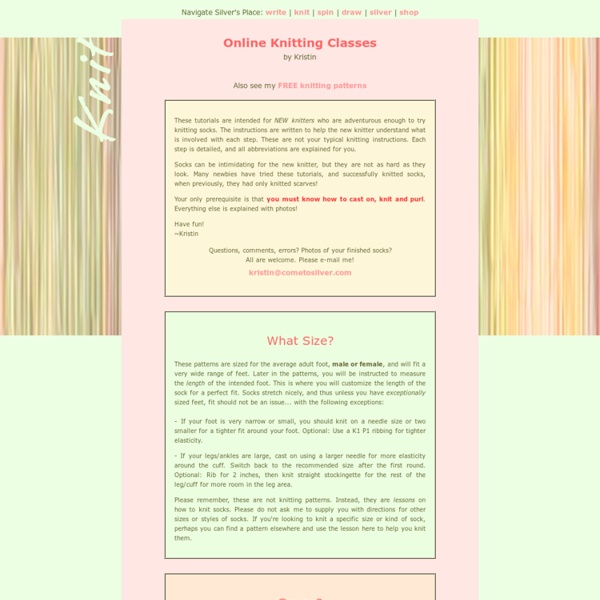Knitty Socks
Repeat these last two rows until all the stitches have been worked. The right side will be facing. Knit 1 row on all stitches. For the mathematically inclined, the number of stitches you have now is x/6+2, rounded up to an even number. On your 48-stitch sock, that's 10. 5. If you put half of your stitches on a holder in step 3, return them to a needle. Knit the stitches that remain on the heel. Using a new needle, pick up the required number of stitches along the first side, using the loops created by the slipping in step 2. Using another new needle, knit across the instep (non-heel) stitches. Using one more new needle, pick up the required number of stitches across the other side, using the loops created by the slipping in step 2. You will now have a small number of stitches left on your needle, ready to be worked. 6. On the very next round, work a decrease round: Decrease Round Needle 1: Knit to last three stitches, k2tog, k1 Needle 2: Knit even Needle 3: K1, SKP, knit to end of needle
Crochet Spot & Blog Archive & How To Crochet: Broomstick Lace
You can use a very large knitting needle for bigger loops and you can create different rows with different size stitches. The only stitch that you need to know is single crochet, can you believe it? For this tutorial, I used my favorite crochet thread in size 3 with a size C crochet hook and a size 17 knitting needle. The usual grouping of stitches is 4 to 6. Chain 20. Insert crochet hook into each chain, yarn over and bring the loop up onto the knitting needle. You should now have 20 loops on your knitting needle. In groups of 5, gather the stitches off the knitting needle. Now begin to draw up your working yarn and chain 1 to close the group. Now make 5 single crochets in the space for the gathered stitches. Continue across row gathering 5 stitches, and making 5 single crochets in each group. Now 4 groups of 5 stitches made. Hook a loop onto your knitting needle at the working end of your row. You should now have 20 loops on the knitting needle.
Crochet School
Sorry I've taken so long to post this very last post of the crochet school series. Would you believe me if I said I don't want it to end? haha That's not the real reason, although it is a little weird to be writing the last crochet school post (for now). I've just been busy designing new patterns and crocheting my butt off for the craft show I'm in next month, Deluxe. I was also waiting for all of you to have time to put in questions you want answered in this post. Let's cover those questions first: Carly asked "I think you mentioned that you can weave in ends with a hook. Hi carly, Since you're making a blanket, I would probably just try to find a bigger needle. Nia asked "I understand how to make the corners when seaming horizontally but what about vertically.. do we skip the corners and just seam the sides? Since you only do one corner from each side when seaming horizontally, you'll pick up those other two corners when you to the vertical stitches. Don't be afraid to ask for help!
Anthro-Inspired Mirror & Flamingo Toes
You all know we love a good Anthropologie knockoff around here – so a couple of days ago when I was browsing online I came across this mirror. Oh I definitely need that. Hold the presses – did that say $498??? Huh. So after scouring the thrift shops, cutting myself on mirror glass, and overcoming an unreasonable fear of Mod Podge, here is my version! (Bear with me here – taking a picture of a mirror is a bit tricky. Ready for the tutorial? You’ll need: A MirrorEasy Off Oven CleanerFabric (enough to cover the frame and the back of the mirror)Mod PodgeA Staple Gun or other framing tool I went searching for a method to removing silvering and came across a great tutorial at Mitzi’s Collectibles. I started with a frame that I found at the thrift store. Obviously not clean. We actually had to ask on this one – because it just said 1951. $19.51 seemed way to high – and it was. Start by taking your mirror out of the frame. Lay your mirror down on a protected surface. Now walk away. Keep scrubbing.
Teddy Fox Pattern - Silver Seams
See photographs of some results from this pattern in the gallery. Copyright/Licenses Copyright 2006 Silver Seams. This work is licensed under a Creative Commons Attribution-Share Alike 3.0 United States License. This work is licensed under a Creative Commons Attribution-Noncommercial 3.0 United States License. If you're not sure what that means, the Open Source Sewing index has more details. The Pattern Teddy Fox 1 - HeadTeddy Fox 2 - Back and LegTeddy Fox 3 - Front and ArmTeddy Fox 4 - Tail These are just photographs of my working patterns, scribbles and all. General teddy-bear construction instructions can be found in any teddy bear making book (and in many other places on the Internet), so I won't repeat them here. His arms have what are sometimes called "teardrop" pawpads (though the point of the teardrop has been cut off, split, and attached to the arm pattern) - like the legs, the arm pieces are sewn together, then the pawpad is sewn in the same way as the foot pad is.



